South China Sea Dispute: International Relations and Geopolitics
VerifiedAdded on 2020/05/04
|16
|4665
|79
Report
AI Summary
This report provides a comprehensive analysis of the South China Sea dispute, exploring its historical context, the involved parties (China, ASEAN nations), and the competing territorial claims over islands and maritime areas. It examines the impasse between China and other claimant states, highlighting China's assertive actions such as island-building and militarization, and the responses of other nations and international bodies. The report delves into the chronological timeline of the dispute, the failure of ASEAN to reach a consensus, and the difficulties experienced in resolving the conflict. It discusses the strategic significance of the South China Sea, including its importance for international trade, resource exploitation, and freedom of navigation, and concludes by assessing the broader implications for regional security and stability. The report draws on various sources to present a balanced and informative overview of this complex geopolitical issue.
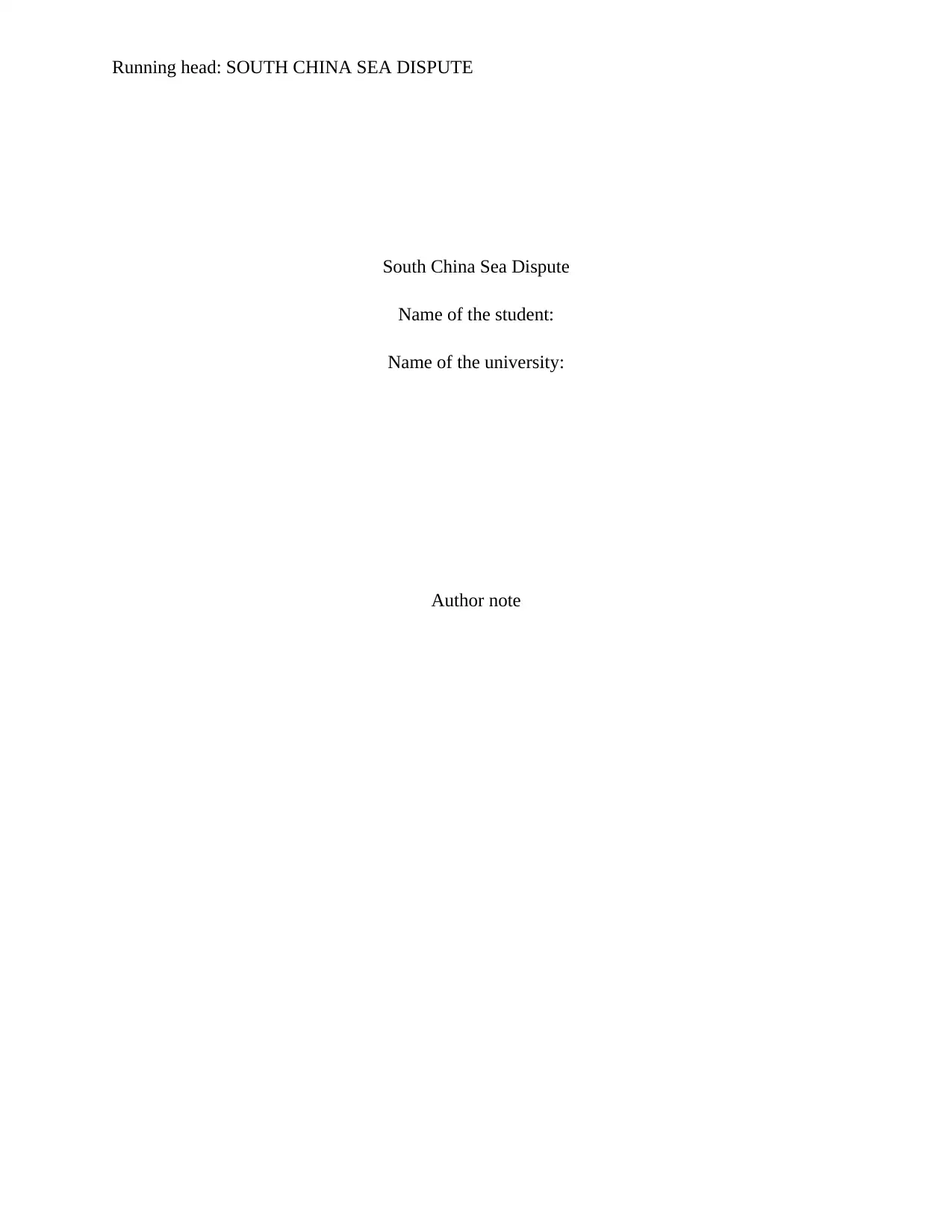
Running head: SOUTH CHINA SEA DISPUTE
South China Sea Dispute
Name of the student:
Name of the university:
Author note
South China Sea Dispute
Name of the student:
Name of the university:
Author note
Paraphrase This Document
Need a fresh take? Get an instant paraphrase of this document with our AI Paraphraser
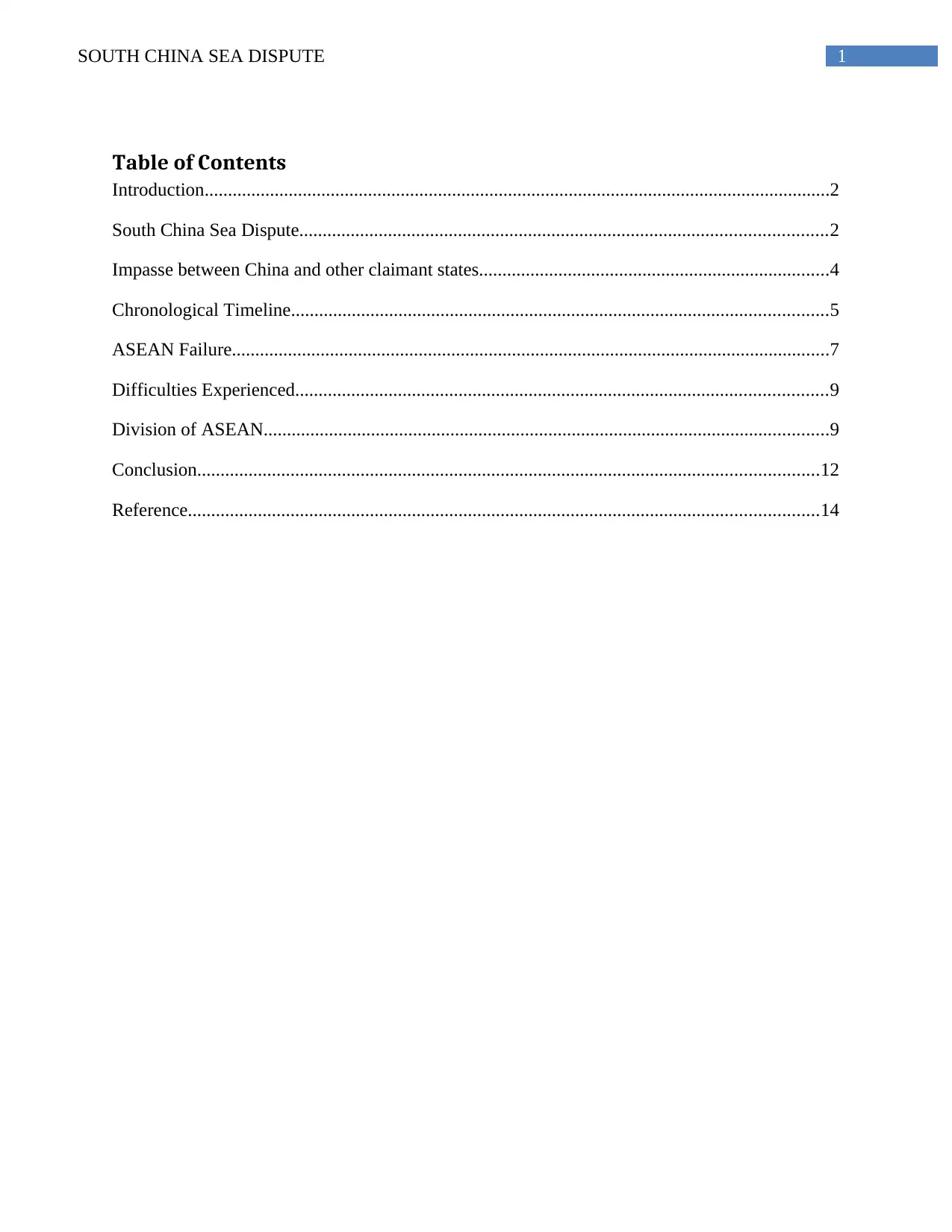
1SOUTH CHINA SEA DISPUTE
Table of Contents
Introduction......................................................................................................................................2
South China Sea Dispute.................................................................................................................2
Impasse between China and other claimant states...........................................................................4
Chronological Timeline...................................................................................................................5
ASEAN Failure................................................................................................................................7
Difficulties Experienced..................................................................................................................9
Division of ASEAN.........................................................................................................................9
Conclusion.....................................................................................................................................12
Reference.......................................................................................................................................14
Table of Contents
Introduction......................................................................................................................................2
South China Sea Dispute.................................................................................................................2
Impasse between China and other claimant states...........................................................................4
Chronological Timeline...................................................................................................................5
ASEAN Failure................................................................................................................................7
Difficulties Experienced..................................................................................................................9
Division of ASEAN.........................................................................................................................9
Conclusion.....................................................................................................................................12
Reference.......................................................................................................................................14
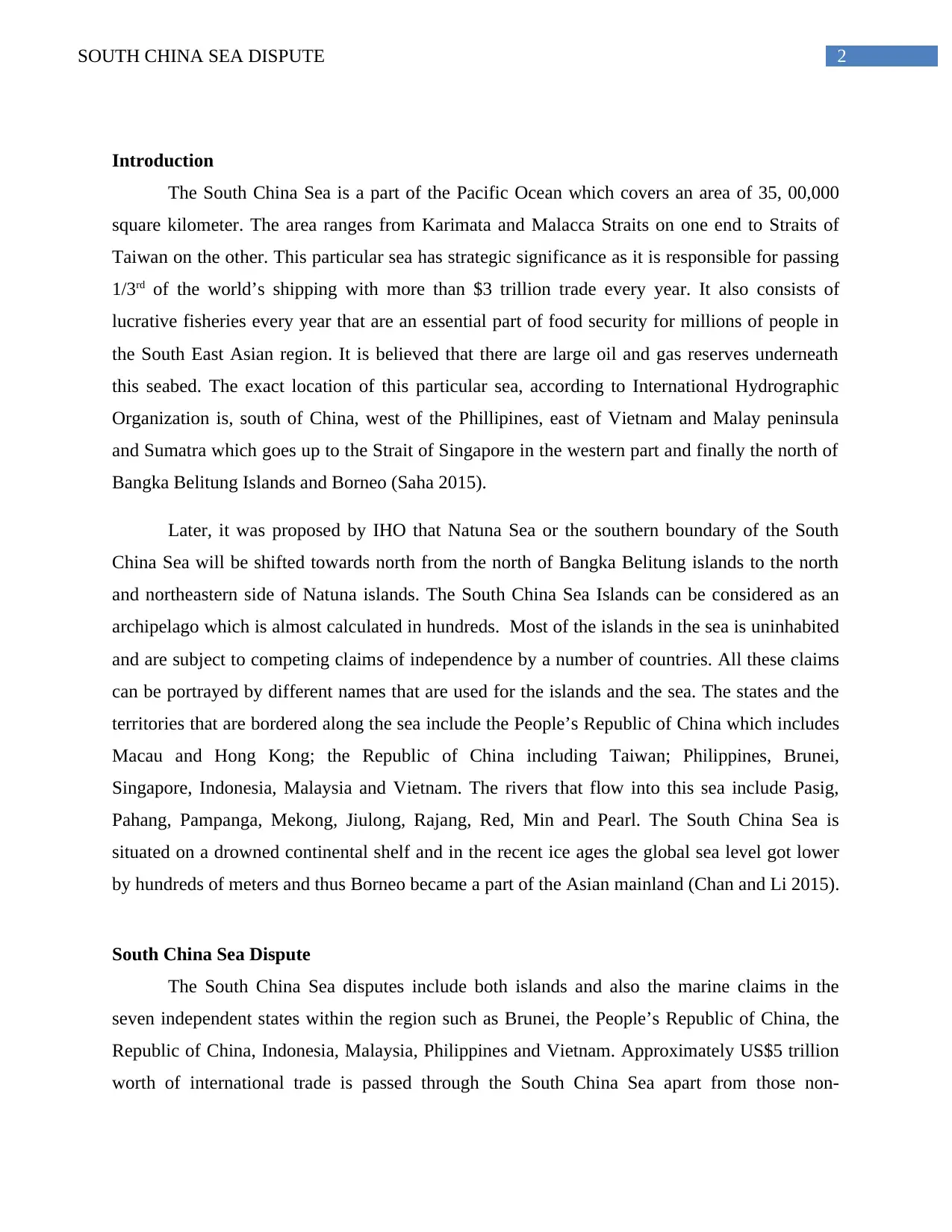
2SOUTH CHINA SEA DISPUTE
Introduction
The South China Sea is a part of the Pacific Ocean which covers an area of 35, 00,000
square kilometer. The area ranges from Karimata and Malacca Straits on one end to Straits of
Taiwan on the other. This particular sea has strategic significance as it is responsible for passing
1/3rd of the world’s shipping with more than $3 trillion trade every year. It also consists of
lucrative fisheries every year that are an essential part of food security for millions of people in
the South East Asian region. It is believed that there are large oil and gas reserves underneath
this seabed. The exact location of this particular sea, according to International Hydrographic
Organization is, south of China, west of the Phillipines, east of Vietnam and Malay peninsula
and Sumatra which goes up to the Strait of Singapore in the western part and finally the north of
Bangka Belitung Islands and Borneo (Saha 2015).
Later, it was proposed by IHO that Natuna Sea or the southern boundary of the South
China Sea will be shifted towards north from the north of Bangka Belitung islands to the north
and northeastern side of Natuna islands. The South China Sea Islands can be considered as an
archipelago which is almost calculated in hundreds. Most of the islands in the sea is uninhabited
and are subject to competing claims of independence by a number of countries. All these claims
can be portrayed by different names that are used for the islands and the sea. The states and the
territories that are bordered along the sea include the People’s Republic of China which includes
Macau and Hong Kong; the Republic of China including Taiwan; Philippines, Brunei,
Singapore, Indonesia, Malaysia and Vietnam. The rivers that flow into this sea include Pasig,
Pahang, Pampanga, Mekong, Jiulong, Rajang, Red, Min and Pearl. The South China Sea is
situated on a drowned continental shelf and in the recent ice ages the global sea level got lower
by hundreds of meters and thus Borneo became a part of the Asian mainland (Chan and Li 2015).
South China Sea Dispute
The South China Sea disputes include both islands and also the marine claims in the
seven independent states within the region such as Brunei, the People’s Republic of China, the
Republic of China, Indonesia, Malaysia, Philippines and Vietnam. Approximately US$5 trillion
worth of international trade is passed through the South China Sea apart from those non-
Introduction
The South China Sea is a part of the Pacific Ocean which covers an area of 35, 00,000
square kilometer. The area ranges from Karimata and Malacca Straits on one end to Straits of
Taiwan on the other. This particular sea has strategic significance as it is responsible for passing
1/3rd of the world’s shipping with more than $3 trillion trade every year. It also consists of
lucrative fisheries every year that are an essential part of food security for millions of people in
the South East Asian region. It is believed that there are large oil and gas reserves underneath
this seabed. The exact location of this particular sea, according to International Hydrographic
Organization is, south of China, west of the Phillipines, east of Vietnam and Malay peninsula
and Sumatra which goes up to the Strait of Singapore in the western part and finally the north of
Bangka Belitung Islands and Borneo (Saha 2015).
Later, it was proposed by IHO that Natuna Sea or the southern boundary of the South
China Sea will be shifted towards north from the north of Bangka Belitung islands to the north
and northeastern side of Natuna islands. The South China Sea Islands can be considered as an
archipelago which is almost calculated in hundreds. Most of the islands in the sea is uninhabited
and are subject to competing claims of independence by a number of countries. All these claims
can be portrayed by different names that are used for the islands and the sea. The states and the
territories that are bordered along the sea include the People’s Republic of China which includes
Macau and Hong Kong; the Republic of China including Taiwan; Philippines, Brunei,
Singapore, Indonesia, Malaysia and Vietnam. The rivers that flow into this sea include Pasig,
Pahang, Pampanga, Mekong, Jiulong, Rajang, Red, Min and Pearl. The South China Sea is
situated on a drowned continental shelf and in the recent ice ages the global sea level got lower
by hundreds of meters and thus Borneo became a part of the Asian mainland (Chan and Li 2015).
South China Sea Dispute
The South China Sea disputes include both islands and also the marine claims in the
seven independent states within the region such as Brunei, the People’s Republic of China, the
Republic of China, Indonesia, Malaysia, Philippines and Vietnam. Approximately US$5 trillion
worth of international trade is passed through the South China Sea apart from those non-
⊘ This is a preview!⊘
Do you want full access?
Subscribe today to unlock all pages.

Trusted by 1+ million students worldwide
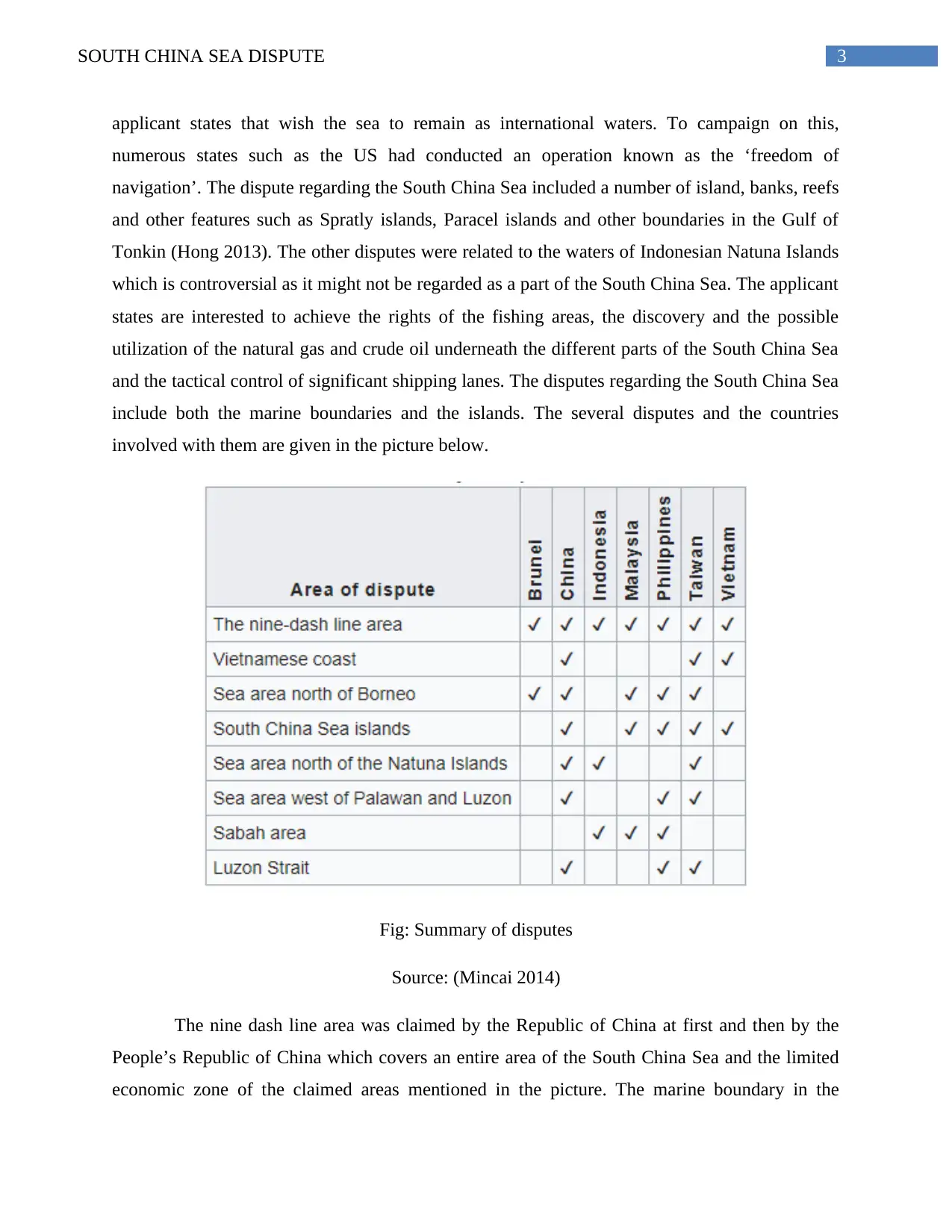
3SOUTH CHINA SEA DISPUTE
applicant states that wish the sea to remain as international waters. To campaign on this,
numerous states such as the US had conducted an operation known as the ‘freedom of
navigation’. The dispute regarding the South China Sea included a number of island, banks, reefs
and other features such as Spratly islands, Paracel islands and other boundaries in the Gulf of
Tonkin (Hong 2013). The other disputes were related to the waters of Indonesian Natuna Islands
which is controversial as it might not be regarded as a part of the South China Sea. The applicant
states are interested to achieve the rights of the fishing areas, the discovery and the possible
utilization of the natural gas and crude oil underneath the different parts of the South China Sea
and the tactical control of significant shipping lanes. The disputes regarding the South China Sea
include both the marine boundaries and the islands. The several disputes and the countries
involved with them are given in the picture below.
Fig: Summary of disputes
Source: (Mincai 2014)
The nine dash line area was claimed by the Republic of China at first and then by the
People’s Republic of China which covers an entire area of the South China Sea and the limited
economic zone of the claimed areas mentioned in the picture. The marine boundary in the
applicant states that wish the sea to remain as international waters. To campaign on this,
numerous states such as the US had conducted an operation known as the ‘freedom of
navigation’. The dispute regarding the South China Sea included a number of island, banks, reefs
and other features such as Spratly islands, Paracel islands and other boundaries in the Gulf of
Tonkin (Hong 2013). The other disputes were related to the waters of Indonesian Natuna Islands
which is controversial as it might not be regarded as a part of the South China Sea. The applicant
states are interested to achieve the rights of the fishing areas, the discovery and the possible
utilization of the natural gas and crude oil underneath the different parts of the South China Sea
and the tactical control of significant shipping lanes. The disputes regarding the South China Sea
include both the marine boundaries and the islands. The several disputes and the countries
involved with them are given in the picture below.
Fig: Summary of disputes
Source: (Mincai 2014)
The nine dash line area was claimed by the Republic of China at first and then by the
People’s Republic of China which covers an entire area of the South China Sea and the limited
economic zone of the claimed areas mentioned in the picture. The marine boundary in the
Paraphrase This Document
Need a fresh take? Get an instant paraphrase of this document with our AI Paraphraser
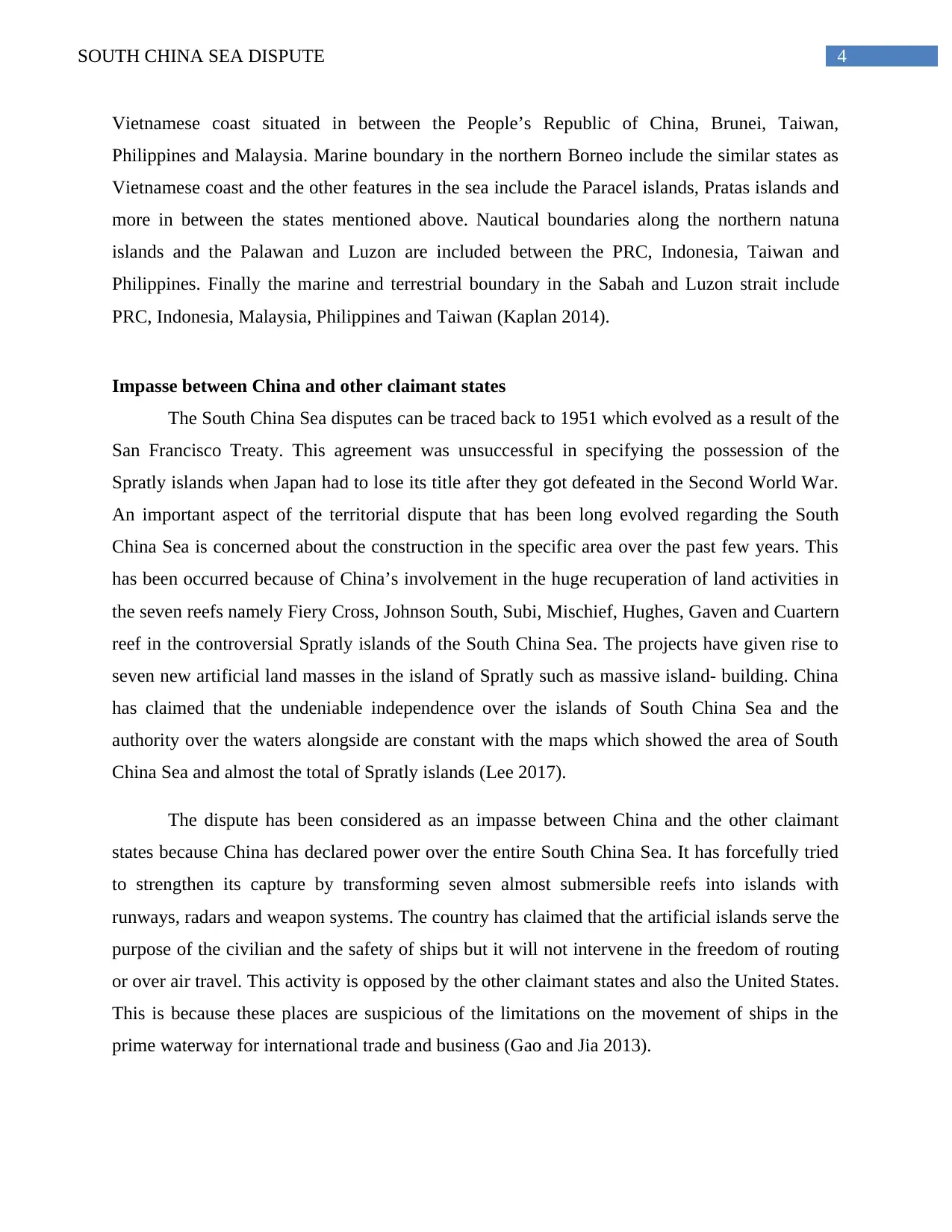
4SOUTH CHINA SEA DISPUTE
Vietnamese coast situated in between the People’s Republic of China, Brunei, Taiwan,
Philippines and Malaysia. Marine boundary in the northern Borneo include the similar states as
Vietnamese coast and the other features in the sea include the Paracel islands, Pratas islands and
more in between the states mentioned above. Nautical boundaries along the northern natuna
islands and the Palawan and Luzon are included between the PRC, Indonesia, Taiwan and
Philippines. Finally the marine and terrestrial boundary in the Sabah and Luzon strait include
PRC, Indonesia, Malaysia, Philippines and Taiwan (Kaplan 2014).
Impasse between China and other claimant states
The South China Sea disputes can be traced back to 1951 which evolved as a result of the
San Francisco Treaty. This agreement was unsuccessful in specifying the possession of the
Spratly islands when Japan had to lose its title after they got defeated in the Second World War.
An important aspect of the territorial dispute that has been long evolved regarding the South
China Sea is concerned about the construction in the specific area over the past few years. This
has been occurred because of China’s involvement in the huge recuperation of land activities in
the seven reefs namely Fiery Cross, Johnson South, Subi, Mischief, Hughes, Gaven and Cuartern
reef in the controversial Spratly islands of the South China Sea. The projects have given rise to
seven new artificial land masses in the island of Spratly such as massive island- building. China
has claimed that the undeniable independence over the islands of South China Sea and the
authority over the waters alongside are constant with the maps which showed the area of South
China Sea and almost the total of Spratly islands (Lee 2017).
The dispute has been considered as an impasse between China and the other claimant
states because China has declared power over the entire South China Sea. It has forcefully tried
to strengthen its capture by transforming seven almost submersible reefs into islands with
runways, radars and weapon systems. The country has claimed that the artificial islands serve the
purpose of the civilian and the safety of ships but it will not intervene in the freedom of routing
or over air travel. This activity is opposed by the other claimant states and also the United States.
This is because these places are suspicious of the limitations on the movement of ships in the
prime waterway for international trade and business (Gao and Jia 2013).
Vietnamese coast situated in between the People’s Republic of China, Brunei, Taiwan,
Philippines and Malaysia. Marine boundary in the northern Borneo include the similar states as
Vietnamese coast and the other features in the sea include the Paracel islands, Pratas islands and
more in between the states mentioned above. Nautical boundaries along the northern natuna
islands and the Palawan and Luzon are included between the PRC, Indonesia, Taiwan and
Philippines. Finally the marine and terrestrial boundary in the Sabah and Luzon strait include
PRC, Indonesia, Malaysia, Philippines and Taiwan (Kaplan 2014).
Impasse between China and other claimant states
The South China Sea disputes can be traced back to 1951 which evolved as a result of the
San Francisco Treaty. This agreement was unsuccessful in specifying the possession of the
Spratly islands when Japan had to lose its title after they got defeated in the Second World War.
An important aspect of the territorial dispute that has been long evolved regarding the South
China Sea is concerned about the construction in the specific area over the past few years. This
has been occurred because of China’s involvement in the huge recuperation of land activities in
the seven reefs namely Fiery Cross, Johnson South, Subi, Mischief, Hughes, Gaven and Cuartern
reef in the controversial Spratly islands of the South China Sea. The projects have given rise to
seven new artificial land masses in the island of Spratly such as massive island- building. China
has claimed that the undeniable independence over the islands of South China Sea and the
authority over the waters alongside are constant with the maps which showed the area of South
China Sea and almost the total of Spratly islands (Lee 2017).
The dispute has been considered as an impasse between China and the other claimant
states because China has declared power over the entire South China Sea. It has forcefully tried
to strengthen its capture by transforming seven almost submersible reefs into islands with
runways, radars and weapon systems. The country has claimed that the artificial islands serve the
purpose of the civilian and the safety of ships but it will not intervene in the freedom of routing
or over air travel. This activity is opposed by the other claimant states and also the United States.
This is because these places are suspicious of the limitations on the movement of ships in the
prime waterway for international trade and business (Gao and Jia 2013).
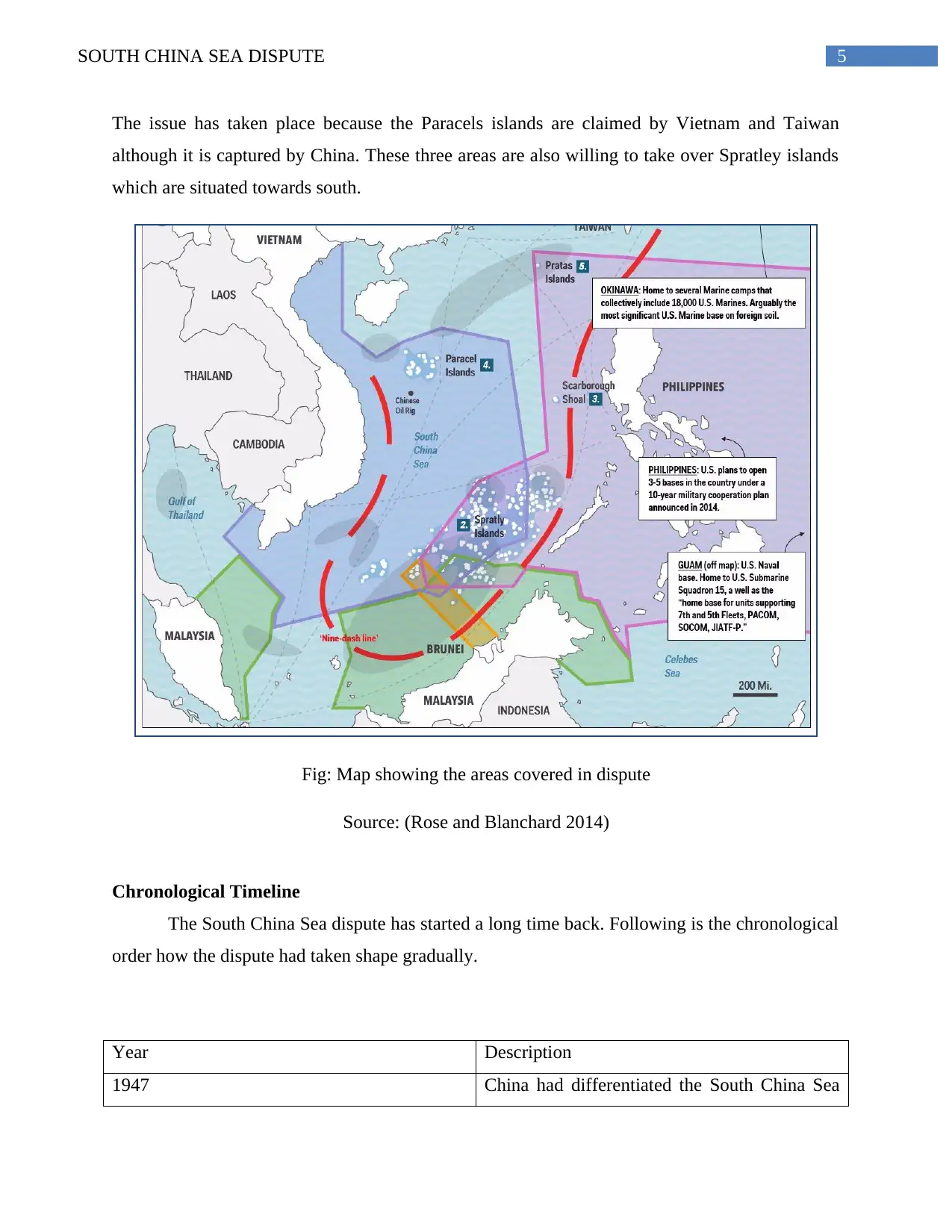
5SOUTH CHINA SEA DISPUTE
The issue has taken place because the Paracels islands are claimed by Vietnam and Taiwan
although it is captured by China. These three areas are also willing to take over Spratley islands
which are situated towards south.
Fig: Map showing the areas covered in dispute
Source: (Rose and Blanchard 2014)
Chronological Timeline
The South China Sea dispute has started a long time back. Following is the chronological
order how the dispute had taken shape gradually.
Year Description
1947 China had differentiated the South China Sea
The issue has taken place because the Paracels islands are claimed by Vietnam and Taiwan
although it is captured by China. These three areas are also willing to take over Spratley islands
which are situated towards south.
Fig: Map showing the areas covered in dispute
Source: (Rose and Blanchard 2014)
Chronological Timeline
The South China Sea dispute has started a long time back. Following is the chronological
order how the dispute had taken shape gradually.
Year Description
1947 China had differentiated the South China Sea
⊘ This is a preview!⊘
Do you want full access?
Subscribe today to unlock all pages.

Trusted by 1+ million students worldwide
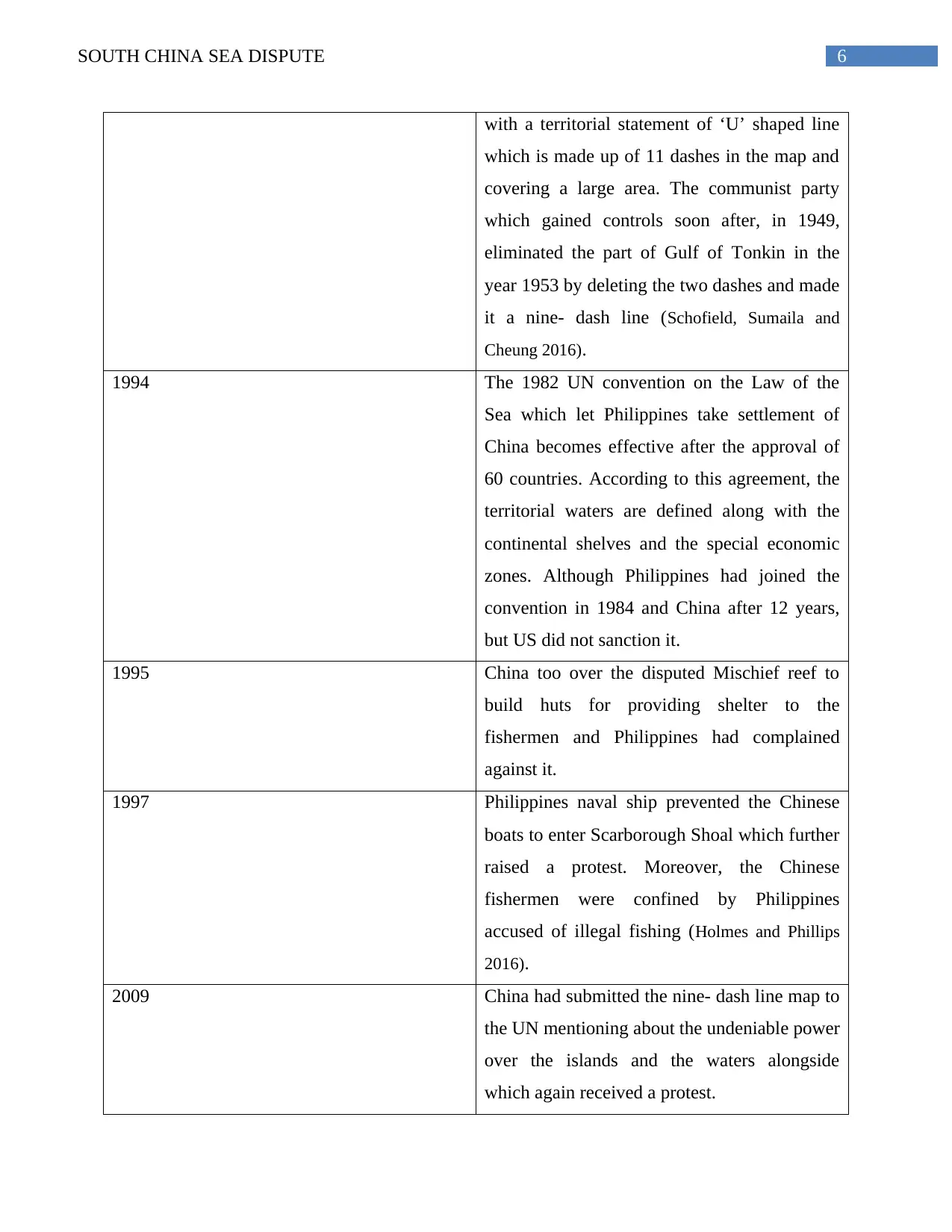
6SOUTH CHINA SEA DISPUTE
with a territorial statement of ‘U’ shaped line
which is made up of 11 dashes in the map and
covering a large area. The communist party
which gained controls soon after, in 1949,
eliminated the part of Gulf of Tonkin in the
year 1953 by deleting the two dashes and made
it a nine- dash line (Schofield, Sumaila and
Cheung 2016).
1994 The 1982 UN convention on the Law of the
Sea which let Philippines take settlement of
China becomes effective after the approval of
60 countries. According to this agreement, the
territorial waters are defined along with the
continental shelves and the special economic
zones. Although Philippines had joined the
convention in 1984 and China after 12 years,
but US did not sanction it.
1995 China too over the disputed Mischief reef to
build huts for providing shelter to the
fishermen and Philippines had complained
against it.
1997 Philippines naval ship prevented the Chinese
boats to enter Scarborough Shoal which further
raised a protest. Moreover, the Chinese
fishermen were confined by Philippines
accused of illegal fishing (Holmes and Phillips
2016).
2009 China had submitted the nine- dash line map to
the UN mentioning about the undeniable power
over the islands and the waters alongside
which again received a protest.
with a territorial statement of ‘U’ shaped line
which is made up of 11 dashes in the map and
covering a large area. The communist party
which gained controls soon after, in 1949,
eliminated the part of Gulf of Tonkin in the
year 1953 by deleting the two dashes and made
it a nine- dash line (Schofield, Sumaila and
Cheung 2016).
1994 The 1982 UN convention on the Law of the
Sea which let Philippines take settlement of
China becomes effective after the approval of
60 countries. According to this agreement, the
territorial waters are defined along with the
continental shelves and the special economic
zones. Although Philippines had joined the
convention in 1984 and China after 12 years,
but US did not sanction it.
1995 China too over the disputed Mischief reef to
build huts for providing shelter to the
fishermen and Philippines had complained
against it.
1997 Philippines naval ship prevented the Chinese
boats to enter Scarborough Shoal which further
raised a protest. Moreover, the Chinese
fishermen were confined by Philippines
accused of illegal fishing (Holmes and Phillips
2016).
2009 China had submitted the nine- dash line map to
the UN mentioning about the undeniable power
over the islands and the waters alongside
which again received a protest.
Paraphrase This Document
Need a fresh take? Get an instant paraphrase of this document with our AI Paraphraser
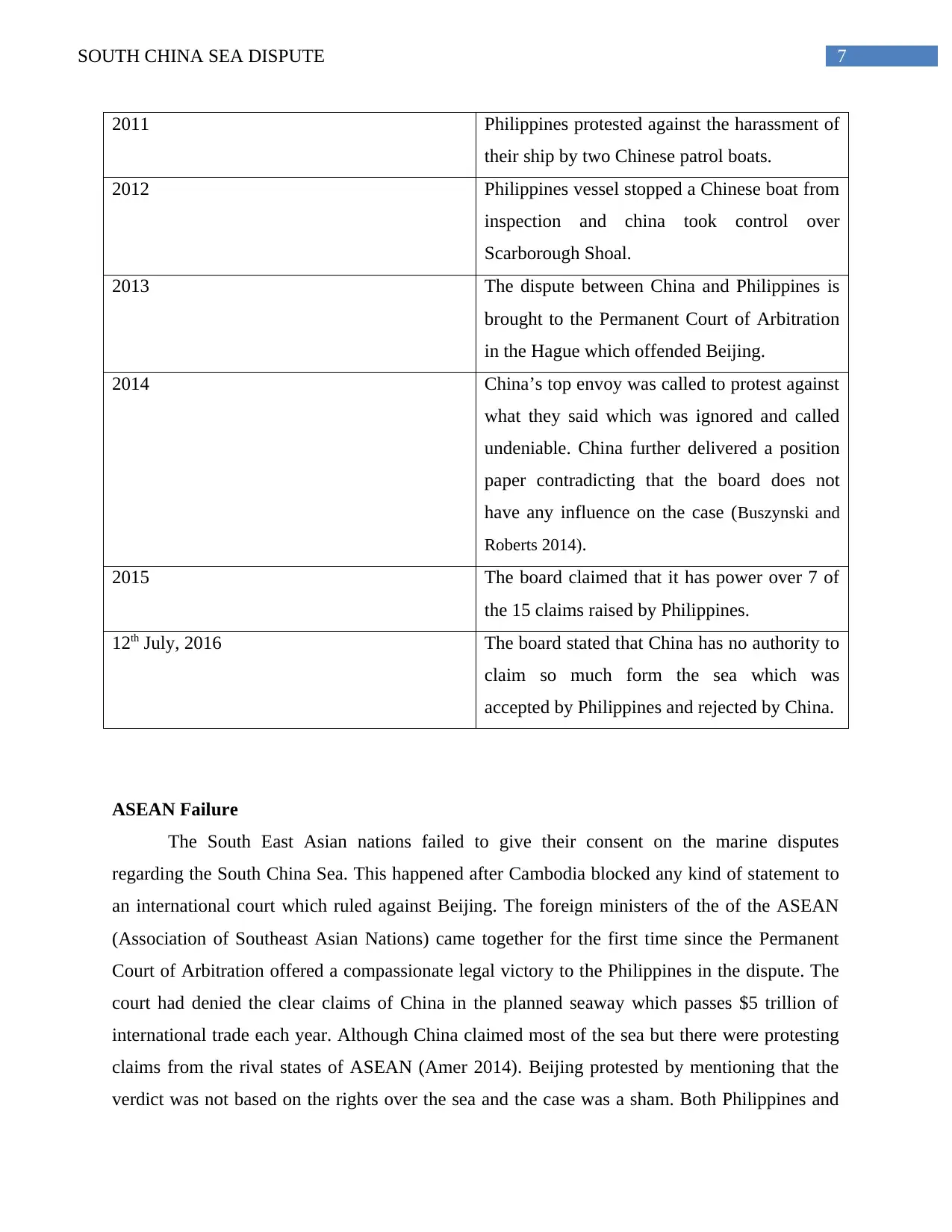
7SOUTH CHINA SEA DISPUTE
2011 Philippines protested against the harassment of
their ship by two Chinese patrol boats.
2012 Philippines vessel stopped a Chinese boat from
inspection and china took control over
Scarborough Shoal.
2013 The dispute between China and Philippines is
brought to the Permanent Court of Arbitration
in the Hague which offended Beijing.
2014 China’s top envoy was called to protest against
what they said which was ignored and called
undeniable. China further delivered a position
paper contradicting that the board does not
have any influence on the case (Buszynski and
Roberts 2014).
2015 The board claimed that it has power over 7 of
the 15 claims raised by Philippines.
12th July, 2016 The board stated that China has no authority to
claim so much form the sea which was
accepted by Philippines and rejected by China.
ASEAN Failure
The South East Asian nations failed to give their consent on the marine disputes
regarding the South China Sea. This happened after Cambodia blocked any kind of statement to
an international court which ruled against Beijing. The foreign ministers of the of the ASEAN
(Association of Southeast Asian Nations) came together for the first time since the Permanent
Court of Arbitration offered a compassionate legal victory to the Philippines in the dispute. The
court had denied the clear claims of China in the planned seaway which passes $5 trillion of
international trade each year. Although China claimed most of the sea but there were protesting
claims from the rival states of ASEAN (Amer 2014). Beijing protested by mentioning that the
verdict was not based on the rights over the sea and the case was a sham. Both Philippines and
2011 Philippines protested against the harassment of
their ship by two Chinese patrol boats.
2012 Philippines vessel stopped a Chinese boat from
inspection and china took control over
Scarborough Shoal.
2013 The dispute between China and Philippines is
brought to the Permanent Court of Arbitration
in the Hague which offended Beijing.
2014 China’s top envoy was called to protest against
what they said which was ignored and called
undeniable. China further delivered a position
paper contradicting that the board does not
have any influence on the case (Buszynski and
Roberts 2014).
2015 The board claimed that it has power over 7 of
the 15 claims raised by Philippines.
12th July, 2016 The board stated that China has no authority to
claim so much form the sea which was
accepted by Philippines and rejected by China.
ASEAN Failure
The South East Asian nations failed to give their consent on the marine disputes
regarding the South China Sea. This happened after Cambodia blocked any kind of statement to
an international court which ruled against Beijing. The foreign ministers of the of the ASEAN
(Association of Southeast Asian Nations) came together for the first time since the Permanent
Court of Arbitration offered a compassionate legal victory to the Philippines in the dispute. The
court had denied the clear claims of China in the planned seaway which passes $5 trillion of
international trade each year. Although China claimed most of the sea but there were protesting
claims from the rival states of ASEAN (Amer 2014). Beijing protested by mentioning that the
verdict was not based on the rights over the sea and the case was a sham. Both Philippines and
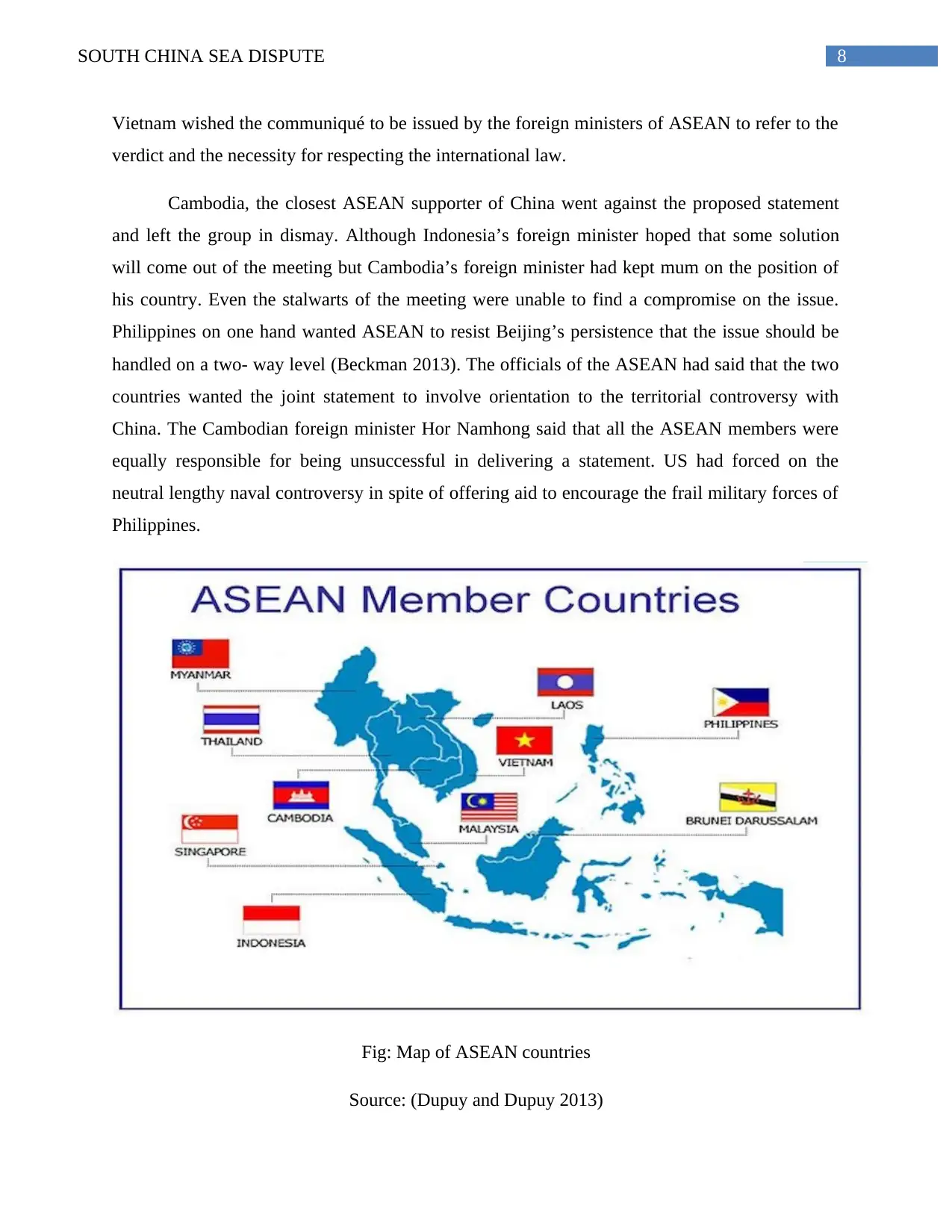
8SOUTH CHINA SEA DISPUTE
Vietnam wished the communiqué to be issued by the foreign ministers of ASEAN to refer to the
verdict and the necessity for respecting the international law.
Cambodia, the closest ASEAN supporter of China went against the proposed statement
and left the group in dismay. Although Indonesia’s foreign minister hoped that some solution
will come out of the meeting but Cambodia’s foreign minister had kept mum on the position of
his country. Even the stalwarts of the meeting were unable to find a compromise on the issue.
Philippines on one hand wanted ASEAN to resist Beijing’s persistence that the issue should be
handled on a two- way level (Beckman 2013). The officials of the ASEAN had said that the two
countries wanted the joint statement to involve orientation to the territorial controversy with
China. The Cambodian foreign minister Hor Namhong said that all the ASEAN members were
equally responsible for being unsuccessful in delivering a statement. US had forced on the
neutral lengthy naval controversy in spite of offering aid to encourage the frail military forces of
Philippines.
Fig: Map of ASEAN countries
Source: (Dupuy and Dupuy 2013)
Vietnam wished the communiqué to be issued by the foreign ministers of ASEAN to refer to the
verdict and the necessity for respecting the international law.
Cambodia, the closest ASEAN supporter of China went against the proposed statement
and left the group in dismay. Although Indonesia’s foreign minister hoped that some solution
will come out of the meeting but Cambodia’s foreign minister had kept mum on the position of
his country. Even the stalwarts of the meeting were unable to find a compromise on the issue.
Philippines on one hand wanted ASEAN to resist Beijing’s persistence that the issue should be
handled on a two- way level (Beckman 2013). The officials of the ASEAN had said that the two
countries wanted the joint statement to involve orientation to the territorial controversy with
China. The Cambodian foreign minister Hor Namhong said that all the ASEAN members were
equally responsible for being unsuccessful in delivering a statement. US had forced on the
neutral lengthy naval controversy in spite of offering aid to encourage the frail military forces of
Philippines.
Fig: Map of ASEAN countries
Source: (Dupuy and Dupuy 2013)
⊘ This is a preview!⊘
Do you want full access?
Subscribe today to unlock all pages.

Trusted by 1+ million students worldwide
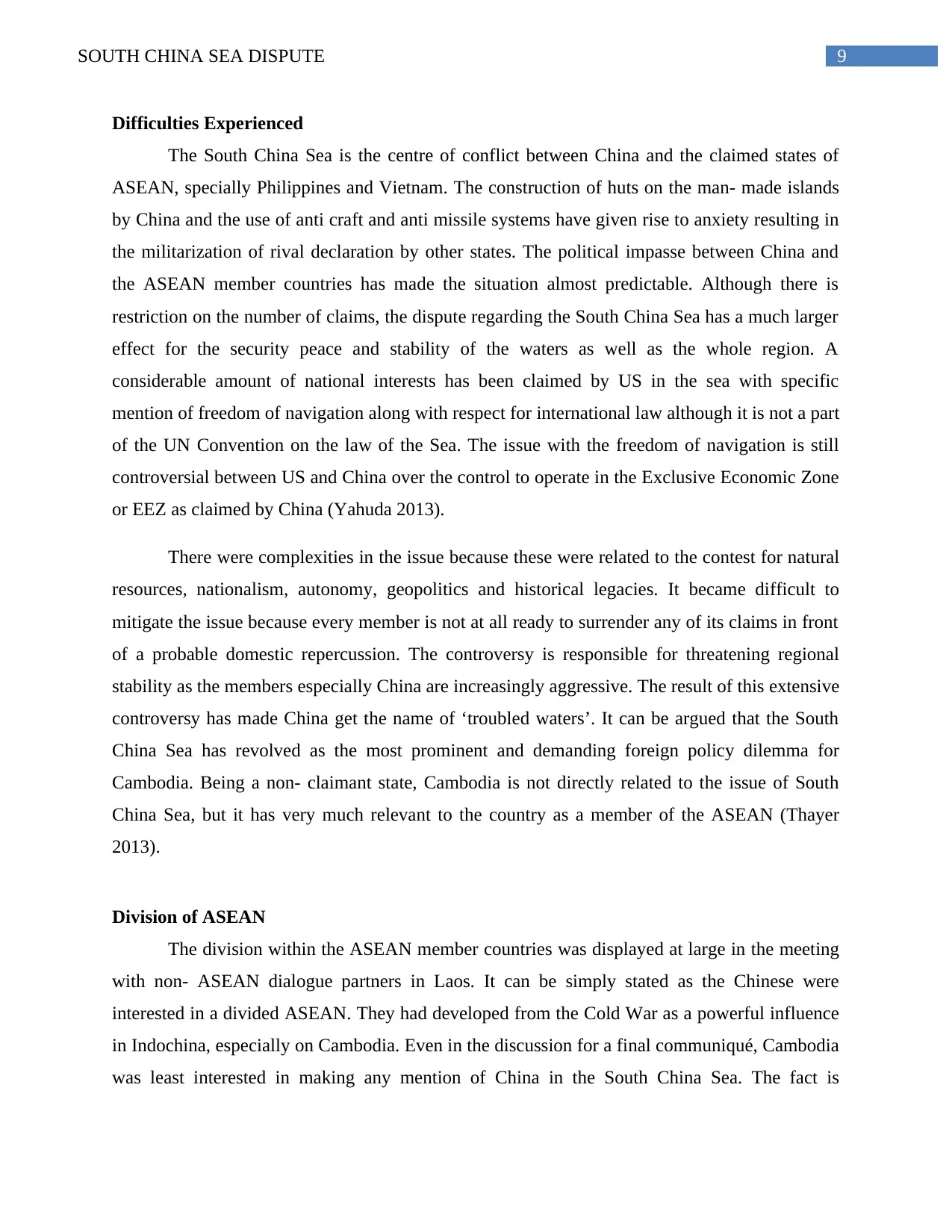
9SOUTH CHINA SEA DISPUTE
Difficulties Experienced
The South China Sea is the centre of conflict between China and the claimed states of
ASEAN, specially Philippines and Vietnam. The construction of huts on the man- made islands
by China and the use of anti craft and anti missile systems have given rise to anxiety resulting in
the militarization of rival declaration by other states. The political impasse between China and
the ASEAN member countries has made the situation almost predictable. Although there is
restriction on the number of claims, the dispute regarding the South China Sea has a much larger
effect for the security peace and stability of the waters as well as the whole region. A
considerable amount of national interests has been claimed by US in the sea with specific
mention of freedom of navigation along with respect for international law although it is not a part
of the UN Convention on the law of the Sea. The issue with the freedom of navigation is still
controversial between US and China over the control to operate in the Exclusive Economic Zone
or EEZ as claimed by China (Yahuda 2013).
There were complexities in the issue because these were related to the contest for natural
resources, nationalism, autonomy, geopolitics and historical legacies. It became difficult to
mitigate the issue because every member is not at all ready to surrender any of its claims in front
of a probable domestic repercussion. The controversy is responsible for threatening regional
stability as the members especially China are increasingly aggressive. The result of this extensive
controversy has made China get the name of ‘troubled waters’. It can be argued that the South
China Sea has revolved as the most prominent and demanding foreign policy dilemma for
Cambodia. Being a non- claimant state, Cambodia is not directly related to the issue of South
China Sea, but it has very much relevant to the country as a member of the ASEAN (Thayer
2013).
Division of ASEAN
The division within the ASEAN member countries was displayed at large in the meeting
with non- ASEAN dialogue partners in Laos. It can be simply stated as the Chinese were
interested in a divided ASEAN. They had developed from the Cold War as a powerful influence
in Indochina, especially on Cambodia. Even in the discussion for a final communiqué, Cambodia
was least interested in making any mention of China in the South China Sea. The fact is
Difficulties Experienced
The South China Sea is the centre of conflict between China and the claimed states of
ASEAN, specially Philippines and Vietnam. The construction of huts on the man- made islands
by China and the use of anti craft and anti missile systems have given rise to anxiety resulting in
the militarization of rival declaration by other states. The political impasse between China and
the ASEAN member countries has made the situation almost predictable. Although there is
restriction on the number of claims, the dispute regarding the South China Sea has a much larger
effect for the security peace and stability of the waters as well as the whole region. A
considerable amount of national interests has been claimed by US in the sea with specific
mention of freedom of navigation along with respect for international law although it is not a part
of the UN Convention on the law of the Sea. The issue with the freedom of navigation is still
controversial between US and China over the control to operate in the Exclusive Economic Zone
or EEZ as claimed by China (Yahuda 2013).
There were complexities in the issue because these were related to the contest for natural
resources, nationalism, autonomy, geopolitics and historical legacies. It became difficult to
mitigate the issue because every member is not at all ready to surrender any of its claims in front
of a probable domestic repercussion. The controversy is responsible for threatening regional
stability as the members especially China are increasingly aggressive. The result of this extensive
controversy has made China get the name of ‘troubled waters’. It can be argued that the South
China Sea has revolved as the most prominent and demanding foreign policy dilemma for
Cambodia. Being a non- claimant state, Cambodia is not directly related to the issue of South
China Sea, but it has very much relevant to the country as a member of the ASEAN (Thayer
2013).
Division of ASEAN
The division within the ASEAN member countries was displayed at large in the meeting
with non- ASEAN dialogue partners in Laos. It can be simply stated as the Chinese were
interested in a divided ASEAN. They had developed from the Cold War as a powerful influence
in Indochina, especially on Cambodia. Even in the discussion for a final communiqué, Cambodia
was least interested in making any mention of China in the South China Sea. The fact is
Paraphrase This Document
Need a fresh take? Get an instant paraphrase of this document with our AI Paraphraser
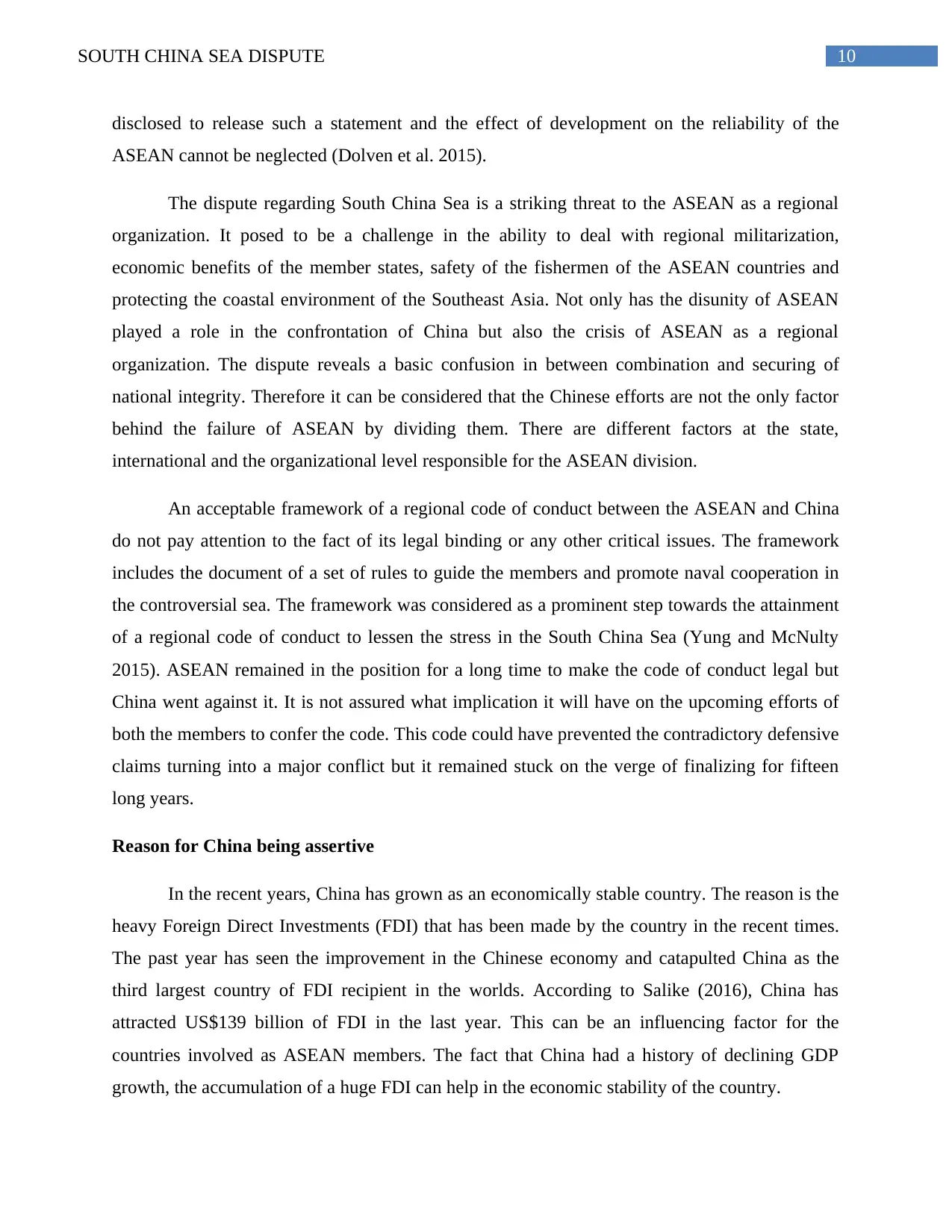
10SOUTH CHINA SEA DISPUTE
disclosed to release such a statement and the effect of development on the reliability of the
ASEAN cannot be neglected (Dolven et al. 2015).
The dispute regarding South China Sea is a striking threat to the ASEAN as a regional
organization. It posed to be a challenge in the ability to deal with regional militarization,
economic benefits of the member states, safety of the fishermen of the ASEAN countries and
protecting the coastal environment of the Southeast Asia. Not only has the disunity of ASEAN
played a role in the confrontation of China but also the crisis of ASEAN as a regional
organization. The dispute reveals a basic confusion in between combination and securing of
national integrity. Therefore it can be considered that the Chinese efforts are not the only factor
behind the failure of ASEAN by dividing them. There are different factors at the state,
international and the organizational level responsible for the ASEAN division.
An acceptable framework of a regional code of conduct between the ASEAN and China
do not pay attention to the fact of its legal binding or any other critical issues. The framework
includes the document of a set of rules to guide the members and promote naval cooperation in
the controversial sea. The framework was considered as a prominent step towards the attainment
of a regional code of conduct to lessen the stress in the South China Sea (Yung and McNulty
2015). ASEAN remained in the position for a long time to make the code of conduct legal but
China went against it. It is not assured what implication it will have on the upcoming efforts of
both the members to confer the code. This code could have prevented the contradictory defensive
claims turning into a major conflict but it remained stuck on the verge of finalizing for fifteen
long years.
Reason for China being assertive
In the recent years, China has grown as an economically stable country. The reason is the
heavy Foreign Direct Investments (FDI) that has been made by the country in the recent times.
The past year has seen the improvement in the Chinese economy and catapulted China as the
third largest country of FDI recipient in the worlds. According to Salike (2016), China has
attracted US$139 billion of FDI in the last year. This can be an influencing factor for the
countries involved as ASEAN members. The fact that China had a history of declining GDP
growth, the accumulation of a huge FDI can help in the economic stability of the country.
disclosed to release such a statement and the effect of development on the reliability of the
ASEAN cannot be neglected (Dolven et al. 2015).
The dispute regarding South China Sea is a striking threat to the ASEAN as a regional
organization. It posed to be a challenge in the ability to deal with regional militarization,
economic benefits of the member states, safety of the fishermen of the ASEAN countries and
protecting the coastal environment of the Southeast Asia. Not only has the disunity of ASEAN
played a role in the confrontation of China but also the crisis of ASEAN as a regional
organization. The dispute reveals a basic confusion in between combination and securing of
national integrity. Therefore it can be considered that the Chinese efforts are not the only factor
behind the failure of ASEAN by dividing them. There are different factors at the state,
international and the organizational level responsible for the ASEAN division.
An acceptable framework of a regional code of conduct between the ASEAN and China
do not pay attention to the fact of its legal binding or any other critical issues. The framework
includes the document of a set of rules to guide the members and promote naval cooperation in
the controversial sea. The framework was considered as a prominent step towards the attainment
of a regional code of conduct to lessen the stress in the South China Sea (Yung and McNulty
2015). ASEAN remained in the position for a long time to make the code of conduct legal but
China went against it. It is not assured what implication it will have on the upcoming efforts of
both the members to confer the code. This code could have prevented the contradictory defensive
claims turning into a major conflict but it remained stuck on the verge of finalizing for fifteen
long years.
Reason for China being assertive
In the recent years, China has grown as an economically stable country. The reason is the
heavy Foreign Direct Investments (FDI) that has been made by the country in the recent times.
The past year has seen the improvement in the Chinese economy and catapulted China as the
third largest country of FDI recipient in the worlds. According to Salike (2016), China has
attracted US$139 billion of FDI in the last year. This can be an influencing factor for the
countries involved as ASEAN members. The fact that China had a history of declining GDP
growth, the accumulation of a huge FDI can help in the economic stability of the country.
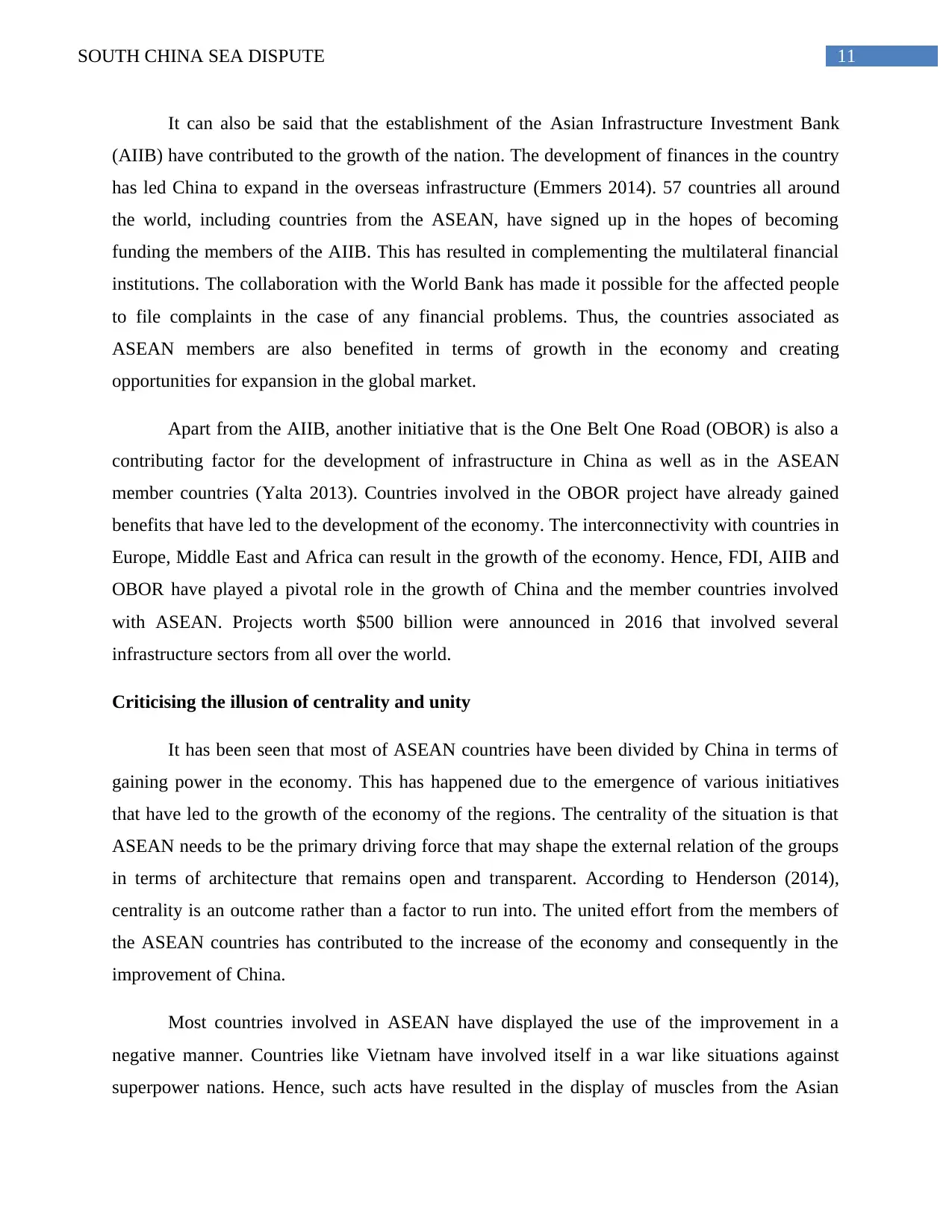
11SOUTH CHINA SEA DISPUTE
It can also be said that the establishment of the Asian Infrastructure Investment Bank
(AIIB) have contributed to the growth of the nation. The development of finances in the country
has led China to expand in the overseas infrastructure (Emmers 2014). 57 countries all around
the world, including countries from the ASEAN, have signed up in the hopes of becoming
funding the members of the AIIB. This has resulted in complementing the multilateral financial
institutions. The collaboration with the World Bank has made it possible for the affected people
to file complaints in the case of any financial problems. Thus, the countries associated as
ASEAN members are also benefited in terms of growth in the economy and creating
opportunities for expansion in the global market.
Apart from the AIIB, another initiative that is the One Belt One Road (OBOR) is also a
contributing factor for the development of infrastructure in China as well as in the ASEAN
member countries (Yalta 2013). Countries involved in the OBOR project have already gained
benefits that have led to the development of the economy. The interconnectivity with countries in
Europe, Middle East and Africa can result in the growth of the economy. Hence, FDI, AIIB and
OBOR have played a pivotal role in the growth of China and the member countries involved
with ASEAN. Projects worth $500 billion were announced in 2016 that involved several
infrastructure sectors from all over the world.
Criticising the illusion of centrality and unity
It has been seen that most of ASEAN countries have been divided by China in terms of
gaining power in the economy. This has happened due to the emergence of various initiatives
that have led to the growth of the economy of the regions. The centrality of the situation is that
ASEAN needs to be the primary driving force that may shape the external relation of the groups
in terms of architecture that remains open and transparent. According to Henderson (2014),
centrality is an outcome rather than a factor to run into. The united effort from the members of
the ASEAN countries has contributed to the increase of the economy and consequently in the
improvement of China.
Most countries involved in ASEAN have displayed the use of the improvement in a
negative manner. Countries like Vietnam have involved itself in a war like situations against
superpower nations. Hence, such acts have resulted in the display of muscles from the Asian
It can also be said that the establishment of the Asian Infrastructure Investment Bank
(AIIB) have contributed to the growth of the nation. The development of finances in the country
has led China to expand in the overseas infrastructure (Emmers 2014). 57 countries all around
the world, including countries from the ASEAN, have signed up in the hopes of becoming
funding the members of the AIIB. This has resulted in complementing the multilateral financial
institutions. The collaboration with the World Bank has made it possible for the affected people
to file complaints in the case of any financial problems. Thus, the countries associated as
ASEAN members are also benefited in terms of growth in the economy and creating
opportunities for expansion in the global market.
Apart from the AIIB, another initiative that is the One Belt One Road (OBOR) is also a
contributing factor for the development of infrastructure in China as well as in the ASEAN
member countries (Yalta 2013). Countries involved in the OBOR project have already gained
benefits that have led to the development of the economy. The interconnectivity with countries in
Europe, Middle East and Africa can result in the growth of the economy. Hence, FDI, AIIB and
OBOR have played a pivotal role in the growth of China and the member countries involved
with ASEAN. Projects worth $500 billion were announced in 2016 that involved several
infrastructure sectors from all over the world.
Criticising the illusion of centrality and unity
It has been seen that most of ASEAN countries have been divided by China in terms of
gaining power in the economy. This has happened due to the emergence of various initiatives
that have led to the growth of the economy of the regions. The centrality of the situation is that
ASEAN needs to be the primary driving force that may shape the external relation of the groups
in terms of architecture that remains open and transparent. According to Henderson (2014),
centrality is an outcome rather than a factor to run into. The united effort from the members of
the ASEAN countries has contributed to the increase of the economy and consequently in the
improvement of China.
Most countries involved in ASEAN have displayed the use of the improvement in a
negative manner. Countries like Vietnam have involved itself in a war like situations against
superpower nations. Hence, such acts have resulted in the display of muscles from the Asian
⊘ This is a preview!⊘
Do you want full access?
Subscribe today to unlock all pages.

Trusted by 1+ million students worldwide
1 out of 16
Related Documents
Your All-in-One AI-Powered Toolkit for Academic Success.
+13062052269
info@desklib.com
Available 24*7 on WhatsApp / Email
![[object Object]](/_next/static/media/star-bottom.7253800d.svg)
Unlock your academic potential
Copyright © 2020–2025 A2Z Services. All Rights Reserved. Developed and managed by ZUCOL.




